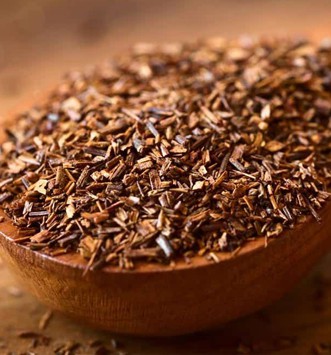
What is rooibos? This red drink from South Africa is gradually replacing teas. Often called red tea, this infusion is however very different. African nature offers the rooibos tree and its drink with a sweet nutty taste. It produces leaves, which when infused in hot water, give a gentle drink filled with health benefits. Let's zoom in on this drink with a thousand virtues, emblematic of South Africa.
Where does rooibos come from?
Rooibos is a red infusion that comes from South Africa. It's a shrub, from the tea family, that grows in the mountains. However, this drink is very different from classic teas. Its composition, rich in antioxidants and low in theine and caffeine, makes it a drink full of health benefits.
In South Africa, rooibos infusion is a highly appreciated drink. This beverage seems to have existed there for several hundred years. The red infusion has been gaining popularity in the West since the 1930s. However, capricious nature only allows the rooibos tree to thrive in the water-deprived mountains of South Africa.
What makes up this red African drink?
Unlike tea and coffee, rooibos infusion contains neither caffeine nor theine. The red drink from the African plant is therefore suitable for children and pregnant women.
The red African drink contains rare antioxidants. Less rich than green tea, rooibos however contains no theine and caffeine. The red Cape infusion has very few tannins.
There are two varieties of rooibos: red rooibos (red tea or infusion) and green rooibos. The color of the drink is defined by fermentation. It should also not be confused with honeybush, another infusion plant from South Africa.
How is a red rooibos drink prepared?
The red African infusion is prepared with leaves. The branches of the rooibos tree are harvested with their leaves. The leaves go through a machine to be crushed. Then, the rooibos leaves are fermented to produce the red African infusion.
The rooibos leaves ferment in the open air. The longer the fermentation, the redder the rooibos infusion.
The rooibos is steeped in hot water. Unlike "classic" teas, the red African drink steeps longer. At the Cape, rooibos steeps for up to 10 minutes in hot water. Even when steeped longer in water, the red African drink doesn't become bitter.
The drink has a slightly sweet taste. Red rooibos can be consumed cold or hot.
In Africa, tradition calls for red rooibos infusion to be served with milk and sugar. In the West, people prefer it plain or with spices.
For variety, red rooibos infusion is sometimes accompanied by spices. The spices that blend with the drink are mild spices like cinnamon, star anise, cardamom, or vanilla. Some also enjoy the effect of strong spices in their rooibos infusion like chili, nutmeg, or red pepper.
For a more surprising effect, many recipes mix red infusion and chai spices. Many recipes allow for variety in enjoyment.
What are the traditional uses of red rooibos infusion?
In Africa, red rooibos infusion is used as a traditional remedy. Nature has endowed it with many benefits.
The main health benefits of the red Cape infusion are:
- its healing properties;
- its digestive properties;
- its antioxidant properties;
- its antiallergic properties;
- its detoxifying properties.
And this, without theine or caffeine. That's a symphony of health benefits.
What does medicine say about red rooibos from the Cape?
Western medicine is interested in the supposed virtues of the red African drink. Rooibos teas, unlike "classic" teas, contain neither caffeine nor theine. This makes their benefits even more interesting for health.
In South Africa, nature seems to offer a perfect health drink for everyone. And this, without side effects. There are multiple recipes, which makes studies complicated. Indeed, depending on their place of cultivation, rooibos teas seem to have different properties.
Traditional consumption of teas from the rooibos tree, meaning the plant and water, poses no particular problems. But, despite the many announced health virtues, the benefits of the plant remain difficult to demonstrate.
In any case, since the infusion is rich in antioxidants and free of theine and caffeine, there's no reason to deprive yourself. Especially since its sweet taste pleases all taste buds. Moreover, the red African drink combines with spices of proven virtues in dozens of recipes. A "Wow" effect in every cup!